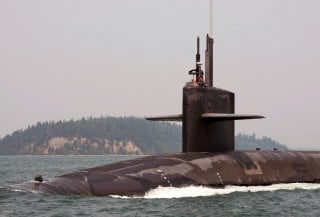Undersea Technologies are One Way to Keep Submarines Safe
Northrop Grumman isn't only good for stealth bombers.
Here's What You Need to Remember: Part of the challenge is finding ways to minimize Navy submarine vulnerability to enemy detection and attack by simply remaining at safer depths, yet in order to achieve a high-degree of high-speed connectivity, submarines need to break the ocean surface by coming to “periscope depth,” which is closer to the surface.
Sub-hunting spy planes armed with torpedoes, maritime drones armed with missiles, high-resolution, surface scanning cameras, and fast-moving surface ships dragging sonar sensors while conducting surface reconnaissance are all fast-growing threats to U.S. Navy submarines.
Part of the challenge is finding ways to minimize Navy submarine vulnerability to enemy detection and attack by simply remaining at safer depths, yet in order to achieve a high-degree of high-speed connectivity, submarines need to break the ocean surface by coming to “periscope depth,” which is closer to the surface.
The U.S. Navy is working with a number of industry partners such as Northrop Grumman to identify, evolve and refine new kinds of undersea communications technology.
“Today, the submarine comes to periscope depth and conducts the majority of its transmissions at this depth. Capabilities we’re developing at Northrop Grumman will allow the submarine to never have to come up to the surface, because it is at its most vulnerable when at periscope depth,” Alan Lytle, vice president of Strategy & Mission Solutions, Maritime/Land Systems & Sensors division, Northrop Grumman, told The National Interest in an interview.
Interestingly, while most people might immediately associate Northrop Grumman with high-profile programs such as its B-2 and B-21 stealth bombers, the company’s history with undersea warfare goes back nearly 100 years, including substantial World War II efforts. Years ago, Northrop Grumman was involved in adapting radio frequency (RF) technologies to undersea acoustic systems and developed the first electric torpedoes for Navy submarines.
“We have been working in the undersea domain for well over 50-years, and our support for the Navy stretches back even further,” said Jenny Roberts, director of strategy, investments & integration, Maritime/Land Systems & Sensors division, Northrop Grumman.
Roberts, who formerly worked as a director for undersea influence at the Navy’s Undersea Warfare Division, says Northrop Grumman innovators seek to align closely with the sense of mission and purpose now driving the U.S. Navy’s push to stay in front of undersea warfare technology.
“We bring together the power of the corporation’s continuous innovation to provide capabilities our Navy customers need for mission success,” Roberts explained to The National Interest. As part of the ongoing effort to synchronize efforts with the Navy, Northrop Grumman developers are placing a special premium on innovation in the areas of undersea warfare and cross-domain networking.
For instance, perhaps a surface drone, submarine, ship, or fighter jet can identify and share time-sensitive targeting data across domains in near real-time, integrating crucial threat information exponentially faster than ever before. The ultimate goal of this is to massively truncate sensor-to-shooter timelines. Perhaps an undersea drone could identify an enemy subsea target, pass the data back to an undersea-warfare commander who in turn instantly sends coordinates to a helicopter armed with Very Light Weight Torpedoes. This innovative kill-chain concept was demonstrated by Northrop Grumman in a Navy exercise.
“To deter future conflict or to ensure we win if future conflict arises, we need to provide capabilities which expand the influence of the undersea force, including connectivity across all domains,” Lytle added.
In light of this, Northrop Grumman developers discuss their efforts to link undersea and space domains in the context of the Pentagon’s fast-evolving Joint All Domain Command and Control initiative. JADC2, as it is called, seeks to engender a kind of multi-node connectivity between otherwise disparate pools of information across multiple domains.
Kris Osborn is the defense editor for the National Interest. Osborn previously served at the Pentagon as a Highly Qualified Expert with the Office of the Assistant Secretary of the Army—Acquisition, Logistics & Technology. Osborn has also worked as an anchor and on-air military specialist at national TV networks. He has appeared as a guest military expert on Fox News, MSNBC, The Military Channel, and The History Channel. He also has a Master’s Degree in Comparative Literature from Columbia University.
This article is being republished due to reader interest.
Image: Flickr.

